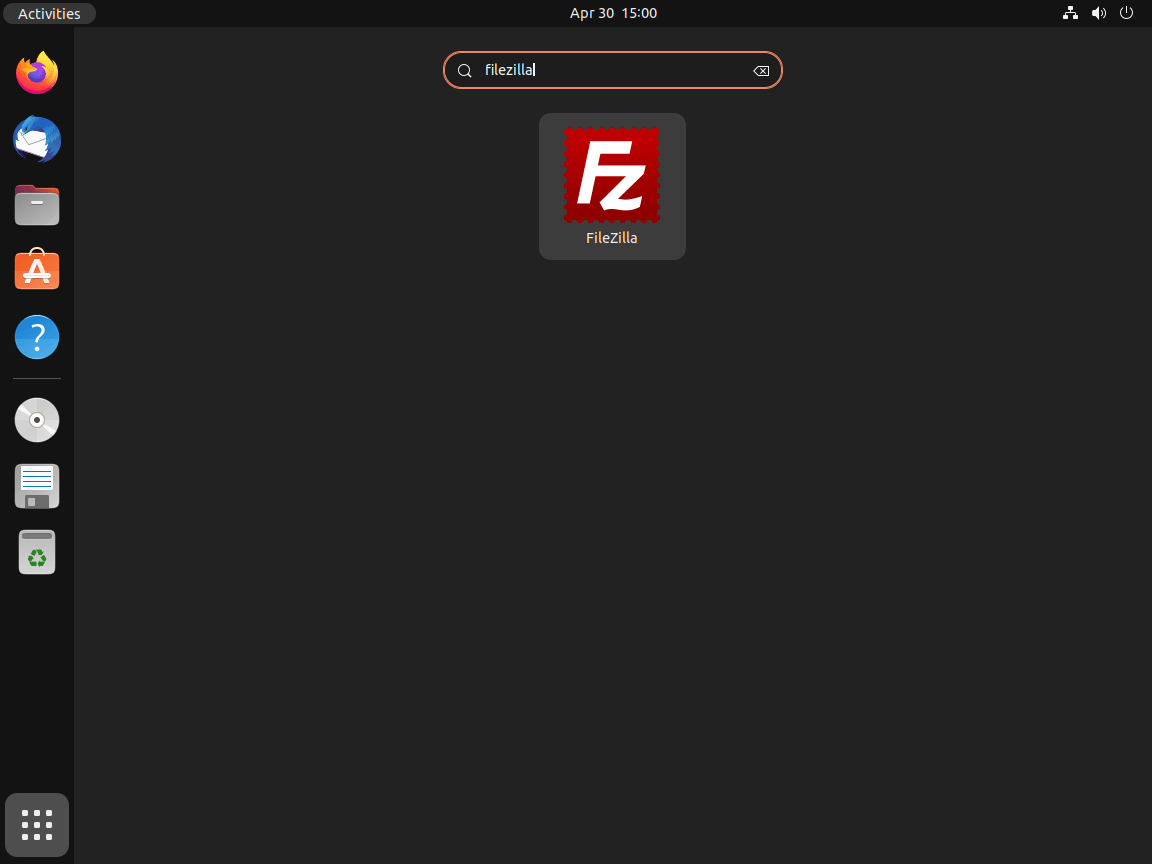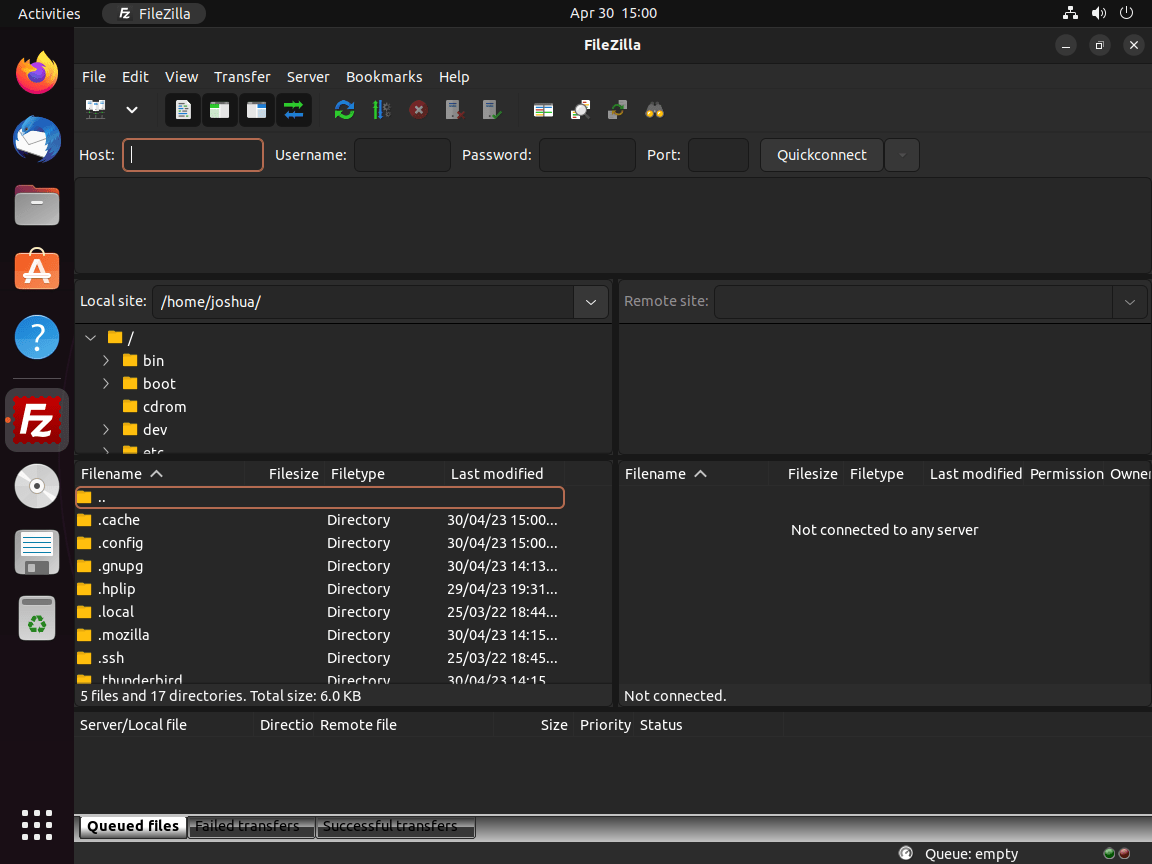FileZilla is a widely used, open-source FTP client that offers a fast and reliable way to transfer files between your local machine and a remote server. Known for its intuitive interface and robust feature set, FileZilla supports various protocols, including FTP, SFTP, and FTPS, making it a versatile tool for managing file transfers. Key features include a site manager, transfer queue, bookmarking, and drag-and-drop support, catering to beginners and advanced users.
The following guide will demonstrate the steps to install FileZilla on Ubuntu 24.04, 22.04, and 20.04 LTS distributions using the command-line terminal. The installation methods involve using Ubuntu’s default APT repository, the PPA by xtradeb, or the alternative Flatpak with the Flathub repository to ensure you get the most up-to-date version available.
Update Ubuntu Before FileZilla Installation
Before installing FileZilla on Ubuntu, updating your Ubuntu system is essential. This ensures that all existing packages are up-to-date and helps avoid potential conflicts during installation. To update your system, execute the following command:
sudo apt update && sudo apt upgrade Method 1 Install FileZilla via APT
Two primary methods to install FileZilla on Ubuntu are using the default Ubuntu repository or a PPA (Personal Package Archive). We will discuss both methods below.
Option 1: Install FileZilla with Ubuntu’s Repository
The first method involves installing FileZilla directly from the Ubuntu default repository. This approach is the easiest but may not provide the most recent version of FileZilla. The default repository may lag behind the latest releases, which could include new features and bug fixes.
To install FileZilla from the Ubuntu repository, execute the following command:
sudo apt install filezillaOption 2: Install FileZilla on Ubuntu with XtraDeb PPA
If you prefer the latest version of FileZilla, consider using a PPA. This method installs FileZilla from the “xtradeb packaging” team PPA, which is known for providing up-to-date software versions.
First, install the necessary packages for adding a PPA to your system with the following command:
sudo apt install software-properties-common apt-transport-https -yNext, import the “xtradeb packaging” team PPA by running the following command:
sudo add-apt-repository ppa:xtradeb/apps -yAfter adding the PPA to your system, update the package list to reflect the newly imported PPA:
sudo apt updateFinally, install FileZilla using the following command:
sudo apt install filezilla -yMethod 2: Install FileZilla on Ubuntu via Flatpak and Flathub
This section explores an alternative approach to installing FileZilla using the popular Flatpak package manager. Unlike conventional installation methods, Flatpak provides a versatile system for installing applications across various Linux distributions without hassle. When you choose Flatpak to install FileZilla, it creates a self-contained environment for the application, ensuring compatibility and timely updates.
Note: If your system does not have Flatpak installed, please refer to our guide on How to Install Flatpak on Ubuntu for step-by-step instructions on installing the most recent supported version of Flatpak.
Enable Flathub For FileZilla
Before installing FileZilla through Flatpak, you must enable the Flathub repository, a primary source for Flatpak applications. To enable Flathub, execute the following command in your terminal:
sudo flatpak remote-add --if-not-exists flathub https://flathub.org/repo/flathub.flatpakrepoThis command adds the Flathub repository to your Flatpak configuration, ensuring you have access to various applications, including FileZilla.
Install FileZilla via Flatpak Command
With Flathub enabled, you can now install FileZilla using the flatpak install command. Run the following command in your terminal:
flatpak install flathub org.filezillaproject.Filezilla -yThis command installs FileZilla from the Flathub repository, providing you with the latest version of the application.
Launching FileZilla via GUI or CLI Methods
After installing FileZilla, you can launch the FTP client in several ways. This section outlines three methods for launching the FileZilla application.
CLI Methods to Launch FileZilla
One way to launch FileZilla is through the terminal. Launching through the terminal allows you to view additional information, such as error messages, that may be useful in debugging.
To launch FileZilla through the terminal, enter the following command in your terminal window:
filezillaFlatpak users can launch FileZilla through the terminal by entering the following command:
flatpak run org.filezillaproject.FilezillaGUI Method to Launch FileZilla
For desktop users, launching FileZilla through the terminal may not be practical. Instead, you can launch FileZilla through the application launcher on your desktop.
To do this, follow the steps below:
- Click on the “Activities” button in the top-left corner of your desktop.
- Type “FileZilla” in the search bar.
- Click on the “FileZilla” icon to launch the application.


Additional FileZilla Commands
Update FileZilla
While FileZilla updates usually appear in notifications, manually checking for the latest version through the terminal is advisable. The commands you need to check for updates depend on whether you used APT or Flatpak for installation.
APT Method to Update FileZilla
To check for updates and upgrade your FileZilla installation using the APT package manager, execute the following command in your terminal:
sudo apt update && sudo apt upgradeFlatpak Method to Update FileZilla
If you installed FileZilla using Flatpak, use the following command to check for updates:
flatpak updateRemove FileZilla
If you no longer need FileZilla, uninstall it using the appropriate command based on your original installation method (APT or Flatpak).
APT Method to Remove FileZilla
When installed, FileZilla adds quite a few dependencies. To keep your system clean and uncluttered, use the autoremove command when uninstalling:
sudo apt remove filezillaIf you installed FileZilla using the Launchpad PPA and do not plan to reinstall the software, remove the PPA using the following command:
sudo add-apt-repository --remove ppa:xtradeb/apps -yFlatpak Method to Remove FileZilla
To remove FileZilla and its associated data when installed using Flatpak, run the following command:
flatpak remove --delete-data org.filezillaproject.Filezilla -yClosing Thoughts
In summary, this guide covered the installation of FileZilla on Ubuntu 24.04, 22.04, and 20.04 LTS using APT with the XtraDeb Applications LaunchPAD PPA and Flatpak with Flathub. Keep your FileZilla updated and always secure your connections. Feel free to explore the settings to tailor the application to your needs. Enjoy smooth and efficient file management on Ubuntu!

